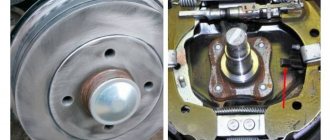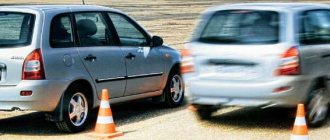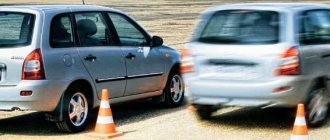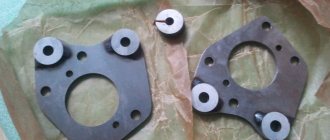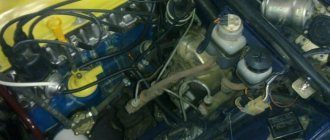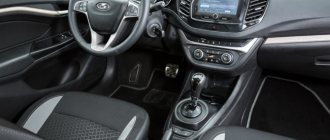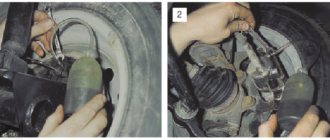What should you prepare for?
Using the example of installing rear disc brakes on a UAZ, you can see that such a design change requires a large number of strictly individual solutions.
In the worst case scenario, you yourself need to take measurements of some components of the rear brake system; some of the information can be found by the vehicle’s VIN code and original spare parts catalogues. Having the necessary measurements, all that remains is to select standard disc brakes from another car. Some elements will have to be selected empirically in an auto parts store, at a car dismantling station, or even ordered from a turner. There are easier ways to replace drums. Judging by the reviews, not a single driver who has replaced drum mechanisms with disc brakes regrets the time and money spent.
Replacement options
- Your car model, but only with a more powerful engine or a later model year, could be equipped with rear disc brakes as standard. You need to check the interchangeability of hub assemblies, brake hose fastenings, and the alignment of the shield seats. We leave the interchangeable components, the remaining elements can be purchased at disassembly. When purchasing used elements, pay attention to the brake shield, which should not be heavily “eaten” by corrosion. Small lesions are acceptable. They must be thoroughly cleaned and painted before installation. It is better to buy brake system hoses, sealing washers and bolts new. All you have to do is remove the old drum brakes and replace them with disc system components. Most likely, the handbrake cable will have to be redone or replaced with a new one.
- Your car was developed on a common basis with models that were standardly equipped with rear disc brakes. This happens if a modern car is largely a redesigned model of older cars, and therefore has many standardized parts from other cars. For example, many components of the rear beam and brake system of Daewoo Lanos/Zaz Chance were equipped with some GM models of the 90s and 2000s (Opel Vectra A, Opel Astra G, etc.). Therefore, replacing drum brakes with disc brakes sometimes does not even require replacing the hub. Despite the available parts ready for installation, DIY replacement requires knowledge of some nuances, many of which are publicly available on specialized forums.
- There are no analogues ready for installation for your car, or you want to design an individual brake system by selecting the desired size of the caliper piston group, the diameter of the rear brake disc, the manufacturer of the components, etc. In this case, you will have to show technical improvisation to replace it. What elements are needed for installation, as well as how to replace the rear brakes with your own hands, we will consider further.
What you need to switch to disc brakes
The standard kit for converting from drum brakes to disc brakes includes:
- 2 brake discs;
- 2 brake calipers (when purchasing used spare parts, it is advisable to immediately inspect the working area of the piston for scoring (there should not be any); before installation, the caliper must be serviced by replacing the boot and lubricating the areas under the guides);
- 2 brake hoses, as well as brackets and fasteners for their fixation;
- fittings, sealing copper washers, bypass bolts;
- 2 brake shields, which may have places for mounting calipers. If these are not provided, a plan washer is needed. Installing the anchor plate may require longer caliper bolts. If it is not possible to purchase an element, the plan washer will have to be sharpened according to an individual drawing;
- parking brake mechanism (the design of the components depends on the type of brake system you choose);
- The handbrake cable is overwhelmingly not suitable, so it also needs to be replaced.
Installation of the Darbis HAZ on Granta
#1 bimulyk
- Users
- 13 messages
- City: St. Petersburg
- Car: Lada Granta
Hi all! I have now installed 2112 wheels with grooves and perforations on my Granta + Brembo pads, now I’m looking at the HRT.
In the instructions https://darbis.ru/upl. 144_instr33.pdf says that to install brakes on a Grant, you need to remove the hub from the axle and put a casing with a faceplate between the axle and the hub, which is a hassle due to removing the hub nut and hub, and then putting everything back together.
Is it possible to install these brakes in the same way as on Priora and 2108-2115 (put the casing and washer between the hub axle and the beam), installing the washer from the kit between the washer and the guide and add 1-2 washers away from you to align the guide relative to brake disc?
In principle, according to my estimates, everything should work out fine, another question is why the manufacturers decided to do this, and not add thicker washers to the kit?
- Top
#2 seasoned
- City: Capital
- Auto: innotaz
Very detailed instructions that I don’t understand.
- Top
#3 bimulyk
- City: St. Petersburg
- Car: Lada Granta
Very detailed instructions that I don’t understand.
Read my post carefully and you will see that you don’t really want to remove the hub from the axle. Everything is clear in the instructions, no doubt about it.
- Top
Number of users reading this topic: 0
0 users, 0 guests, 0 hidden users
Replacing rear drums with VAZ 2109 wheels
On front-wheel drive VAZ cars, a beam is installed at the rear. The design of the rear suspension on many models of VAZ cars is unified, the axle itself is the same on the VAZ-2108-15, almost the same beam is installed on the Lada Kalina and Priora cars, the only difference is that on the Lada Kalina and Lada Priora cars a torsion bar is welded into the axle (transverse stabilizer sustainability). It is for this reason that replacing drum brakes with disc brakes is not particularly difficult - spare parts can be easily purchased at many auto stores, they are almost always in stock.
To replace you will need:
- calipers assemblies (right and left);
- hubs assembled with bearings;
- brake discs;
- set of brake pads.
The hubs can also be left from drum brakes, but in this case you will have to grind down the seats for installing the brake disc, because there are castings on the hubs for the drums. If you don't sharpen the hubs, the disc won't fit tightly into place.
When replacing, one more point should be taken into account - adjusting the brakes on the front and rear axles. Adjustment is made using the adjuster located at the rear left wheel, and when replacing drums with discs, the brake pressure regulator rod needs to be moved forward by about 2-4 mm for all brakes to work effectively.
What needs to be done to the front of the car
When the brake system is damaged, the Lada Granta drives unstably and requires replacement of any components, including the pads. Basically, it is necessary to replace the front brake pads on a Lada Granta only when the linings are damaged or worn down to 1.5 mm.
Before proceeding with the replacement, you should determine the presence of damage, check the brake fluid level, which should not reach the maximum level; this is required by replacing the front brake pads on a Lada.
If there is brake fluid in the reservoir, part of it is pumped out using a bulb or syringe. If this rule is not observed, the piston being lowered into the cylinder provokes the leakage of liquid from this tank. After pumping out the liquid, the pads are installed.
However, the cause of poor braking is not always due to unstable operation of the pads or their wear. If there is a squeak during braking (and not necessarily an emergency), the Lada Granta pads often require replacement. Sometimes, when you try to stop the car, the characteristic squeak that the brake pads emit is absent, but the vibration persists. Most often, this indicates that the discs are wearing unevenly. Another cause is thinning of the front discs or one of them. In any case, a pair replacement of the front discs is required. The brake system of the Lada Grant itself is similar in structure to the system of the Kalina, Vesta or Priora. Therefore, repairs at the component level of the brake system, replacement of brake pads and discs are similar.
Before installing new discs, the surface is thoroughly cleaned and treated. Next, install new front discs and check their operation by pressing the brake several times and checking the brake fluid. Installing pads on a Lada Granta is unacceptable if there are any defects in the operation of the brake system after replacing the disc. First, the disc is brought to normal operation, then it is fixed.
Once the new front discs are secured, the brake pads are installed.
Replacing front drum brakes with UAZ disc brakes
There are many options for replacing drum brakes with disc brakes on UAZs, so we will consider only one of them. So, we carry out the work on a UAZ-31512 car with a “civilian” axle (on the front axle, we perform the replacement alternately, first on one side, then on the other):
- remove the wheel;
- dismantle the hub;
- unscrew the three screws, remove the drum, but first use an eccentric bolt to bring the brake pads together;
- Using a hub wrench, unscrew the two nuts and remove the hub;
- unscrew the bolts securing the brake shield, remove the shield assembled with the pads, having first disconnected the tube from the cylinder;
- dismantle the axle;
- We place a gasket under the axle, coat it with sealant, and attach installation faceplates on top of the axle to secure the caliper;
- mount the hub, tighten it with a nut;
- We put a disk on top of the hub;
- we install the caliper assembly with brake pads on the faceplate, here it is important not to confuse the right and left calipers - it is necessary that the bleeder fitting faces up during installation;
- connect the caliper with the hose, install the hub in place;
- to connect the brake pipe with the hose, you will need an adapter;
- bleed the brakes and put the wheel in place.
To assemble such a design, calipers from the GAZ-3302 (Gazelle) car are suitable; exactly the same calipers are installed on the GAZ-3102 Volga for wheels of 14th radius. Faceplates from Otad are installed under them without widening the wheel track.
Replacing rear drum brakes with disc brakes UAZ-31512
The rear drums are replaced with discs in approximately the same way as the front ones. Let's consider this replacement option:
- remove the rear wheel;
- unscrew the three brake drum screws and remove the part;
- Before removing the drum, we bring the pads together with an eccentric;
- unscrew the axle shaft bolts and dismantle the part;
- Using a hub wrench, unscrew the nuts (2 pcs.), remove the hub;
- unscrew the brake pipe from the cylinder;
- unscrew the 6 bolts securing the shield, remove the support disk complete with pads;
- coat the faceplate with sealant and place it on the back side of the “stocking”;
- the brake shield must be secured with four long bolts, two bolts will remain “original”;
- the faceplate at the back is secured with nuts, it has 4 fastenings in total;
- install the hub, fasten it with nuts, and mount the axle shaft in place;
- install the disk and secure it with three screws;
- We grind the caliper a little from the inside, otherwise it will not fit onto the disc;
- we install the caliper in place, having previously placed the pads in it;
- We must connect the brake pipe to the caliper via a hose - the connection here has become movable, and a directly connected pipe may break off;
- bleed the brakes and put the wheel back in place.
How is a handbrake useful?
In fact, this type of brake does not always work with a handbrake. Depending on the origin and type of car, it can be activated by tightening the lever with your hand, pressing your foot, or a special button, which is why in the technical literature it is tolerantly called parking.
In addition to its main function - immobilizing the car during a long stop, it can be used as an emergency system in case of failure of the main brake. But this is not all the purpose of the hero of today’s article.
How else can it be useful? For example, the handbrake is indispensable when starting up a hill, and is also loved by enthusiasts of aggressive and extreme driving.
The replacement algorithm includes the main steps:
- it is necessary to remove the wheel and jack up the car;
- the old brake pads are removed - to do this, the guide bolts are unscrewed and the caliper is folded back;
- The bracket is carefully hung on the suspension, after which you can begin to remove the disk - two nuts are unscrewed;
- if for some reason the disk cannot be removed from the bolts, you need to lightly hit it with a hammer from the reverse side;
- The new disk is carefully installed.
The nuts are screwed into place. It is advisable to pre-lubricate the threads with graphite lubricant. This will prevent souring. It is advisable to change the pads along with the discs.
The better disc brakes
Drum brakes are different from disc brakes. The operating principle of these systems is different. The disc brake system is considered more modern and efficient, as it has a number of advantages:
- higher degree of heat dissipation generated from friction of brake pads;
- the possibility of uniform application of braking forces;
- shorter braking distance compared to a drum mechanism;
- shorter reaction time to force on the brake pedal.
Features of the brake system replacement process
The process of replacing a drum brake with a disc brake system has many features to consider. The car's brakes are the main safety system that guarantees the life of the driver if they function correctly.
When purchasing disc brakes for a specific car model, you need to make sure that the spare parts are original and have passed Russian standardization, otherwise you may have problems when passing the next mandatory vehicle inspection. Since replacing brakes is a design change, state vehicle inspection experts will definitely pay attention to this.
One of the negative features of replacing brakes is that in the event of an accident, traffic police officers may, without explanation, consider the driver of a car who has unregistered design changes to be the culprit of the accident.
Replacing brakes must be carried out strictly according to the instructions in compliance with all requirements for the specific make and model of the car. Otherwise, the brake system may be adjusted incorrectly and the vehicle's braking performance may be reduced.
What front brake discs should be installed on the Lada Granta
The front wheels of the Lada Granta are equipped with disc shoe brakes. What makes the pedal informative is that it makes it easy to calculate where to stop.
The power reserve with original parts can range from 50 to 120 thousand km. But sooner or later the need for replacement arises.
You can divide all supplied spare parts into two main categories: original and analogues. The former are more expensive. But at the same time, their maximum mileage is usually an order of magnitude greater than their analogues. There is multi-stage quality control in production. The downside is the high cost. Sometimes it is 2-3 times more than analogues.
The latter are distinguished by their availability. But not all parts are reliable. It is best to give preference to well-known brands that have proven themselves on the positive side.
Standard set of disc brakes for a car
Some people will think that replacing rear drum brakes on a car is as simple as purchasing a set of front disc brakes and installing them on the rear hub. However, everything is not so simple. The following table will indicate the standard set of disc brakes for the car and the features of each component.
| Accessories | Peculiarities |
| Brake discs | Standard size brake discs may not always fit the rear hub exactly, so hub grooving may be necessary |
| Brake calipers | The location of the calipers on the rear hub will need to be adjusted so that they do not interfere with other rear suspension components. |
| Brake hoses | Standard front brake hoses will not fit due to their length; longer hoses will need to be selected |
| Plates (faceplates) for calipers | This spare part is non-standard, it will be necessary to order manual work to create them |
| Bolts and engraving washers | Standard equipment |
We will not describe the process of replacing the drum brake mechanism with disc brakes. For each individual car model, you can find instructions for this matter on the Internet.
Which VAZ is better to buy: the model range of the domestic manufacturer
Let's sum it up
avto-flot.ru
For each motorist and for each individual case, choosing a car for a taxi is an entirely individual matter. It is important to realize that it is the right choice in your individual case that can please you and provide normal travel conditions in any situation.
The choice of taxi car depends on the city, the characteristics of working in a taxi service and other important characteristics. Taxi cars can travel up to 1000 kilometers per day, which sets certain limits in terms of quality and endurance. However, if you ride in a taxi after your main job, your mileage will increase by only a hundred kilometers per day. In this case, you can give preference to a cheaper car.
A taxi car will be a good purchase if it is inexpensive and not too expensive to maintain. These are important points that make the purchased car profitable to operate or too expensive. If your car requires constant investment in repairs and maintenance in large quantities, you will not be able to earn much money in a taxi, since you will spend exclusively on the car.
Therefore, you should look for a cheap but reliable car. Many people think about purchasing a used car, but in this case the risks are very high. With such a huge potential mileage, it is better to buy a new car and get a warranty for the next few months.
Lada Granta is the cheapest taxi solution
If you want to make a profit from the first month of using the car in a taxi, the best solution would be to purchase a Lada Granta. This is a domestic compact sedan, created on the basis of previous developments. The changed appearance was not the only update to the AvtoVAZ model line; engine settings have changed significantly, and an automatic has appeared in the trim levels. The main benefits of Lada Grants for taxis are as follows:
- the starting price of the car is only 330,000 rubles, despite inflationary processes in the country;
- Car maintenance may be required quite often, but everything in this car costs pennies;
- The reliability of the machine is quite high, in most cases you will not feel any negative aspects;
- The Lada Granta is quite convenient to use; you can drive 1000 kilometers a day without a sore back;
- the car is ready for significant mileage, the design of the car is very simple, the car can boast of endurance.
These are the features that a domestic car offers as a taxi car. Choosing such a car provides several more important aspects. For example, when purchasing, you can take advantage of preferential loans and other convenient programs, since the domestic manufacturer is actively supported by the state and is promoted to the masses.
Renault Logan - for lovers of foreign cars
A European alternative to Grants with a slightly higher price tag and a different class. The machine is quite simple in its design, very reliable, and prepared for intensive use. Owners of the previous generation of Logan actively used the car in taxis, so the manufacturer provided these features in the new generation:
- the car has a very comfortable place for the driver and passengers;
- the cost of the car remained within 400,000 rubles, which is not much more expensive than the Grant;
- the car does not require maintenance, even basic equipment is very reliable;
- Excellent low consumption criteria allow savings in machine operation;
- no problems with inexpensive regular service and periodic repairs.
DETAILS: How to pass the traffic police exam the first time
The cost of owning a Logan may be even lower than the price of driving a Grant, if you use the French car wisely. The low-power engines under the hood of this car are not too fond of spin-up; they work well at low speeds and provide sufficient dynamics. If you twist them, they begin to eat oil and require maintenance.
Daewoo Gentra - a new representative of the taxi class
Another car that has received the title of one of the best solutions for taxis is Daewoo Gentra. The car offers a very favorable price for the version with an automatic transmission - 500,000 rubles. Considering the fact that the car has a standard 4-automatic transmission with high reliability, an automatic transmission will greatly facilitate the taxi driver’s work and make his everyday life more enjoyable. The main benefits of Gentra are as follows:
- the car costs very affordable money - the basic version will cost 420,000 rubles;
- the car is descended from the Chevrolet Lacetti, a respected and reliable taxi car;
- a large spacious salon provides space for each passenger with high comfort;
- the car drives smoothly, absorbing road unevenness; the suspension remains from the Lacetti;
- Repairing this Korean and Uzbek car will be quite cheap.
Regular maintenance won't take too much money out of your pocket, but you'll have to fork out more at the gas station. The base Lacetti engine was also transferred to the Gentra, and this is a 109-horsepower unit with a fairly high appetite. The car is heavy, you have to turn the engine quite hard. But high consumption can be called the only drawback of the car.
Mitsubishi Lancer X - if you need an executive class
In 2015, Mitsubishi restyled its Lancer X sedan, changing the only body part - the shape of the front bumper. With such changes, the car became one of the most amazing updates, the car has not changed for so many years, and the new generation has also not changed at all. Lancer is bought for an elite taxi. The machine has important advantages:
- the car belongs to the executive class of Japanese production;
- a large and spacious interior and soft suspension confirm its role in a taxi;
- transport costs affordable money - 750,000 rubles in the basic version;
- repair and maintenance of equipment will not cause problems, everything under the hood is classic;
- There are automatic versions that also won't cost you too much money.
Among its competitors in the standard C-Class, the car turned out to be one of the most successful solutions for use in an executive taxi. But if you need a car for private transportation, it is better to choose a cheaper option. Lancer X is only suitable if you will pay more for transportation.
Skoda Octavia is the world leader in taxi ratings
Many companies that open taxi services in Moscow use Skoda Octavia cars of various generations and modifications. Despite their high cost, the cars turn out to be much more profitable than their rivals for a number of reasons. The cars offer many important advantages for use as city and intercity taxis:
- excellent endurance of the car, excellent body options for taxis;
- the presence of station wagons, as well as a basic body in the form of a liftback;
- the basic model will cost the buyer 816,000 rubles - not so expensive;
- There is practically no need to maintain the car, the car is quite reliable;
- Regular service costs much less than that of the same Volkswagen segment.
Let's sum it up
There are several dozen car models that are ideal for taxis. What is important here is the combination of price and quality, as well as potential earnings from the car. It is very important to purchase cars that will provide the highest quality of travel and can provide the necessary resources.
You can give preference to the budget segment and get a low purchase and maintenance price; you can purchase a middle price class and get benefits in terms of operation, travel comfort and potential cost of transportation. Each option has its own advantages and disadvantages.
avto-flot.ru

